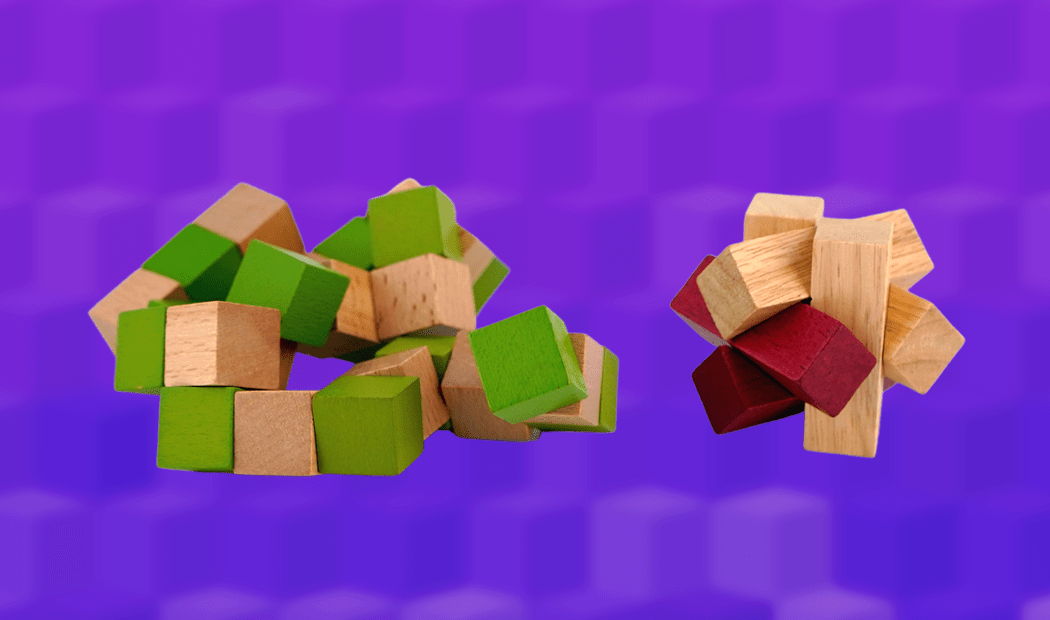
Okay, so what's a metagrobologist? If you’re a Curiosity Box subscriber, especially one who reads these newsletters about the conundrums that arrive in your box, then you are: a metagrobologist is a person who studies and ruminates about puzzles! Even though it sounds like a word cobbled together from latin roots like "meta” and the “graboid” monsters from the sci-fi cinematic classic Tremors, the term was actually created as a joke in the 17th century by french satirist François Rabelais; he invented it as a verb (métagaboulizer) meaning “to puzzle or mystify." Later English-speaking puzzlers turned it into a noun.
So what can we learn about your new puzzles? To start with, far from just a simple set of blocks tied together with a string, snake puzzles model fascinating and complex mathematical concepts, and inspire cutting-edge biological research. And of course, they’ve also got a link to Hamilton - not Alexander, of Broadway (and constitutional) fame, but William Rowan Hamilton, the 19th century mathematician and Royal Astronomer of Ireland, who gives his name to the concept of the Hamiltonian Path.
Hamilton invented a puzzle called the Icosian Game: given an icosahedron, the player needed to find a path around the outer edges which visited each vertex once, and then returned to the start. It’s a brain-challenging mathematical game and led Hamilton to lend his name to the solution: the Hamiltonian Path. An HP is a route through a graph that visits each vertex exactly once; and when solved, that describes your snake puzzle! A properly folded snake puzzle shows a path through a 3 x 3 cubic grid graph that visits each space in the square one time.

This puts the snake puzzle in the category of graphing puzzles, which includes other famous mathematical puzzles that make use of graph theory. Some of the most famous of these, the Five Room Puzzle and the Seven Bridges of Königsberg, eventually were found to be unsolvable. Luckily, your snake puzzle definitely is - it’ll just tax your spatial reasoning and problem solving abilities to their utmost.
It’s also possible to mathematically calculate the possible number of different snake puzzles that can be made; in this case, it turns out that there are 11,487 possible ways to make a snake cube puzzle, each with the blocks attached a different way. And one of the interesting things is that they have different numbers of solutions: some of these snake cubes can be solved in only one way, others have multiple possible solutions - up to 142.
Of those 11,487 possible types, there are six common organizations of the snake puzzle; and they’re often color coded. You can see those iterations on this excellent website. Based on the configurations shown, can you figure out which type you have? Hint: it’s not necessarily related to the green color of your puzzle.
But metagrobology isn’t just about puzzles, it’s sometimes about what else you can learn from them: biologists use the snake cube puzzle to model mechanisms of protein folding. By doing so, they have theorized that the final 3-dimensional structure of some amino acids may in fact be determined by the pattern in which they fold; it’s like saying the snake form of your puzzle was back engineered because they needed a shape that could be folded into that 3 x 3 cube (which is sort of true). You can read one such study here.

The burr puzzle is quite different from the snake, but just as interesting! Burr puzzles have been around for literally hundreds of years, and possibly thousands: there are theories they evolved from Chinese woodworking techniques first developed in the 4th century BCE, and the first one shown in print turns up in the 1698 book Cyclopædia: or, An Universal Dictionary of Arts and Sciences. They became especially popular after metagrobologist Edwin Wyatt included them in his famous 1928 book on wooden puzzles. Wyatt called them "burr puzzles" because the shape reminded him of the burr seeds that sometimes get caught on your clothes when you go hiking.
In the 1970s, Bill Cutler and Arthur Cross started analyzing burr puzzles, calculating how many different ways the pieces could be shaped, and the number of burr puzzles you could create from those pieces. Your burr is what they call a “classic” 6-piece burr, which has 26 possible piece shapes that can be assembled into a puzzle in one of 314 different ways (though each puzzle has only one solution). They even figured out a way to make a puzzle called a Holey 6 Piece Burr, featuring “blind alley, internal space” pieces, whose shapes can be formed into a total of 35,657,131,235 different puzzles! They calculated this out in 1990; at that time the standard computing speed was 8 mhz, at which rate it would have taken 62.5 years of computer time to crunch the numbers. Cutler and Cross were able to cut that down by using the fastest computers of the day, including a Cray-1, one of the first supercomputers.
The Snake and Burr puzzles are mathematical conundrums, engaging problem solving games, and inspirations for scientific discovery, and we hope you enjoy solving them as much as we do!

